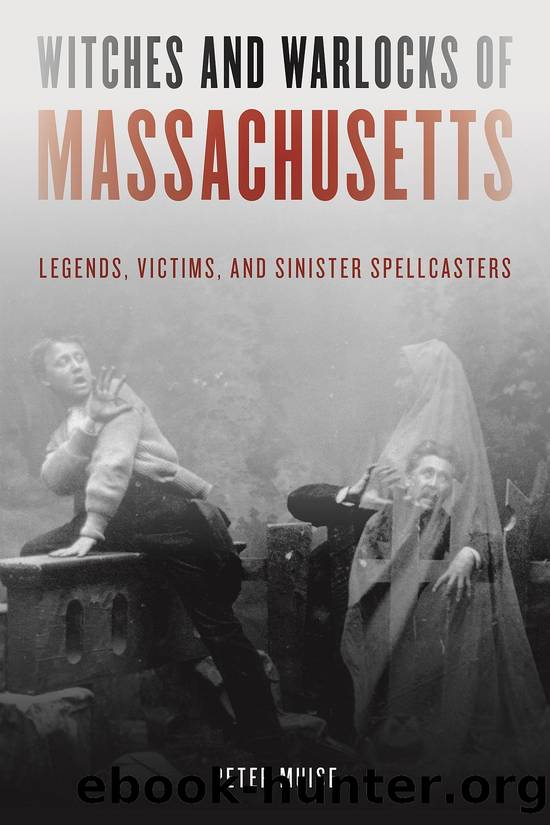Witches and Warlocks of Massachusetts by Peter Muise

Author:Peter Muise
Language: eng
Format: epub
ISBN: 9781493060252
Publisher: Globe Pequot
Deals with the Devil
The afflicted girls of Salem Village continued to accuse people of witchcraft throughout the spring of 1692, and the local constables and magistrates acted upon their accusations. By the end of May more than 60 suspected witches were imprisoned in jails across Essex County and even in Boston, and by the time the trials ended more than 150 people would be accused of being witches. Many were residents of Salem Town and Salem Village, but others were from Andover, Haverhill, Billerica, Gloucester, and other towns across the county. People from all levels of society were accused, from the wealthy merchant Philip English to the African slaves Mary Black and Candy. Both men and women were charged as witches (although the majority were women), and they were of all ages, from four-year-old Dorothy Good to eighty-year-old Lydia Dustin. It seemed as if no one was safe from the accusations.
The number of afflicted girls also grew, from a handful to nearly seventy people. Perhaps the more accurate term would just be âthe afflicted,â because as their number grew it also included some adult women and even a handful of men. Perhaps the oldest of them was Bray Wilkins, an eighty-one-year-old grandfather. But historians generally use the term âafflicted girls,â and Iâll follow their precedent.
William Phips, the Massachusetts colonyâs newly appointed governor, created a special court to investigate the rapidly growing number of witches. Following British law, it was called the Court of Oyer and Terminer, a term which means âto hear and determine.â Phips appointed his lieutenant governor William Stoughton of Dorchester to oversee the court, and eight other magistrates from Haverhill, Boston, and Salem to serve as its judges. Among them were John Hathorne and Jonathan Corwin, who had heard the initial accusations against Sarah Good, Sarah Osborne, and Tituba. Due to the growing number of cases, the trials were moved from Ingersollâs ordinary to the Salem Village meetinghouse and then finally to the Salem Town House, a large civic building in Salem Town.
The colonyâs multistep legal process should have prevented innocent people from being found guilty. Once someone was accused of witchcraft, they were questioned first by several magistrates, then by a grand jury who determined if there was enough evidence to send the case to trial. If there was, it was heard by a jury who determined if the defendant was guilty or innocent of witchcraft.
Unfortunately, the Court of Oyer and Terminer made some bad decisions that allowed the Salem witch trials to grow from a small local disturbance into an enormous, historic tragedy. For example, according to British law a plaintiff (the person making an accusation) was required to pay a monetary fee when accusing an individual of a capital crime like witchcraft. This law was intended to prevent frivolous court cases. Hoping to discover as many witches as possible, the Court of Oyer and Terminer waived this requirement, inadvertently allowing anyone with a grudge to accuse multiple people of witchcraft.
The court also allowed âspectral evidenceâ to be considered during the trials.
Download
This site does not store any files on its server. We only index and link to content provided by other sites. Please contact the content providers to delete copyright contents if any and email us, we'll remove relevant links or contents immediately.
| Americas | African Americans |
| Civil War | Colonial Period |
| Immigrants | Revolution & Founding |
| State & Local |
In Cold Blood by Truman Capote(2702)
Steve Jobs by Walter Isaacson(2459)
All the President's Men by Carl Bernstein & Bob Woodward(1973)
Lonely Planet New York City by Lonely Planet(1857)
The Murder of Marilyn Monroe by Jay Margolis(1752)
The Room Where It Happened by John Bolton;(1729)
The Poisoner's Handbook by Deborah Blum(1672)
And the Band Played On by Randy Shilts(1632)
Lincoln by David Herbert Donald(1622)
The Innovators by Walter Isaacson(1612)
A Colony in a Nation by Chris Hayes(1531)
The Innovators: How a Group of Hackers, Geniuses, and Geeks Created the Digital Revolution by Walter Isaacson(1519)
Under the Banner of Heaven: A Story of Violent Faith by Jon Krakauer(1426)
The Unsettlers by Mark Sundeen(1347)
Amelia Earhart by Doris L. Rich(1346)
Birdmen by Lawrence Goldstone(1346)
Decision Points by George W. Bush(1261)
Dirt by Bill Buford(1247)
Zeitoun by Dave Eggers(1232)
